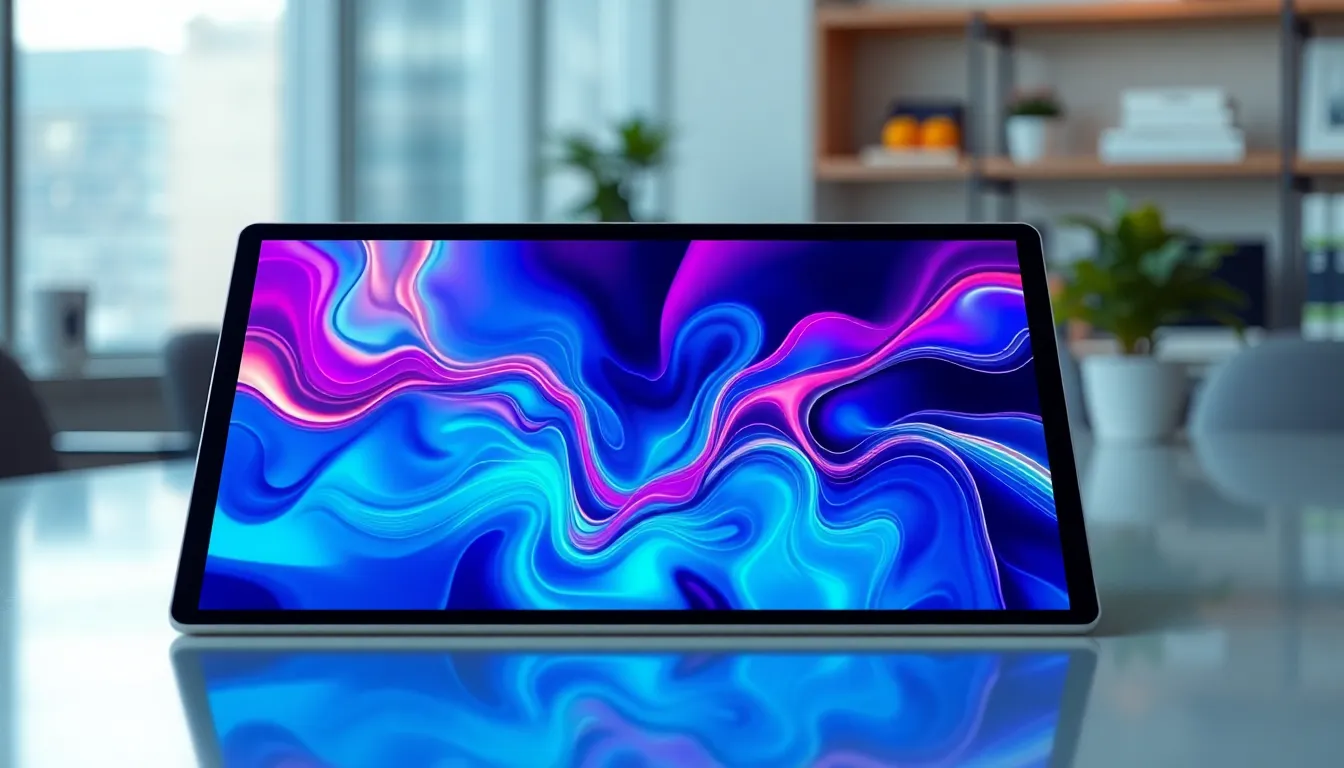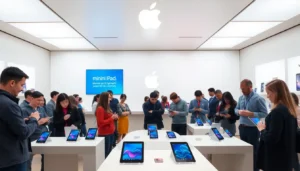Table of Contents
ToggleTablets have transformed the way people interact with technology, blending the convenience of smartphones with the functionality of laptops. As advancements in design and performance continue to emerge, these devices are becoming more than just portable screens; they’re evolving into powerful tools for productivity, creativity, and entertainment.
Innovations in tablet technology are reshaping industries, from education to gaming, enabling users to accomplish tasks with unprecedented ease. With features like enhanced displays, improved battery life, and versatile accessories, tablets are catering to a diverse range of needs. As the market expands, it’s clear that the future of tablets holds even more exciting possibilities.
Recent Tablet Innovations
Recent innovations in tablet technology showcase significant advancements in design and performance. Notable developments include:
- Foldable Displays: Manufacturers like Samsung and Lenovo have introduced tablets with foldable screens. These designs enhance portability and enable users to switch between tablet and laptop forms seamlessly.
- Enhanced Processors: Brands like Apple and Microsoft now feature cutting-edge processors in their tablets. The M1 and Surface Pro X chips boost performance, allowing for smoother multitasking and better application compatibility.
- Improved Battery Life: Tablets now offer longer battery life, with some models providing up to 15 hours of usage on a single charge. This improvement supports extended use without frequent recharging.
- Advanced Stylus Integration: Tablets from Apple and Wacom have improved stylus technology. Features like pressure sensitivity and tilt detection provide users with more accurate and responsive drawing experiences.
- High-Resolution Displays: Devices featuring 4K and even 8K resolution displays deliver stunning visuals and vibrant colors, making them ideal for media consumption and creative work.
- Augmented Reality (AR) Capabilities: Tablets incorporating AR technology allow users to engage in interactive experiences. Apps utilizing this capability are transforming fields like education and design.
- 5G Connectivity: Many new tablets now support 5G networks. This connectivity ensures faster internet speeds, facilitating seamless downloads and streaming.
These innovations illustrate how tablet technology adapts to meet the evolving needs of users, enhancing their productivity, creativity, and entertainment experiences.
Advancements in Display Technology

Recent tablet innovations in display technology significantly enhance user interaction and visual experiences. Advances include higher resolution screens, improved color accuracy, and the emergence of diverse screen technologies.
OLED vs. LCD Screens
OLED screens offer superior contrast and richer colors compared to traditional LCD screens. OLED technology utilizes organic compounds to emit light, allowing for deeper blacks and improved energy efficiency. LCD screens, while still prevalent, typically have backlighting that limits contrast. The choice between OLED and LCD influences viewing experiences across various applications, from gaming to content creation. Devices with OLED often provide vibrant visuals, enhancing graphics and media consumption.
Resolution Improvements
Tablet resolutions have reached impressive levels, with some models offering displays up to 8K. Higher resolutions translate to sharper images and more detailed visuals. This improvement enhances user experiences in graphic design, video editing, and gaming. Many tablets now feature resolutions exceeding Full HD, ensuring crisp text and vibrant images. As manufacturers continue to push resolution boundaries, users can expect even more immersive viewing experiences in future tablet releases.
Battery Life Enhancements
Tablet manufacturers focus on battery life enhancements, making devices more efficient and user-friendly. Innovations include fast charging solutions and energy efficiency improvements.
Fast Charging Solutions
Fast charging technologies significantly reduce the time tablets require to recharge. Current models support charging speeds of up to 65W, enabling users to power their devices in less than two hours. Many brands, such as Samsung and Apple, incorporate proprietary fast charging technology, allowing users to benefit from quick top-ups during busy days. Some tablets now feature USB-C charging ports, providing universal compatibility and convenience for users who own multiple devices.
Energy Efficiency Innovations
Energy efficiency innovations focus on improving battery longevity without sacrificing performance. Recent advancements in processor designs, like ARM architecture, optimize power consumption, enhancing battery life by up to 20%. Additionally, manufacturers implement software optimizations that regulate background processes, ensuring minimal energy usage during idle times. These strategies allow tablets to achieve screen-on times exceeding 15 hours on a single charge, catering to users in need of long-lasting performance for work and entertainment purposes.
Operating System Developments
Operating systems for tablets have evolved significantly, with both iOS and Android introducing groundbreaking features and enhancements that improve user experience and functionality.
New Features in iOS and Android
iOS and Android consistently unveil features that elevate tablet usability. iOS 17 introduces Stage Manager, which supports multitasking by enabling multiple apps to run simultaneously on a single screen. This feature simplifies task management and enhances productivity. Meanwhile, Android 14 focuses on compatibility with larger displays, optimizing app layouts for improved efficiency. Enhanced split-screen multitasking allows users to view multiple apps concurrently with ease. Additionally, both operating systems now support improved file management capabilities, making it simpler to organize, access, and share documents across devices seamlessly.
Customization and User Interface Improvements
Customizability and user interface enhancements define the latest operating system updates. iOS has integrated a widget system that permits users to place app widgets on their home screens, aiding quick access to essential information. The new Control Center in iOS 17 offers users greater accessibility to settings and applications with a streamlined design. Android platforms present extensive personalization options, including customizable app icons and themes, enabling users to tailor their devices to suit their preferences. Both operating systems prioritize user experience with intuitive navigation improvements and AI-driven suggestions that adapt to usage habits, fostering a more personalized interaction with tablets.
Accessories and Ecosystem Expansion
Tablet accessories are crucial for enhancing functionality and user experience. The continuous development in accessories supports the evolving needs of tablet users, creating a more integrated ecosystem.
Enhanced Stylus Capabilities
Stylus technology has advanced significantly, offering features that improve precision and responsiveness. Pressure sensitivity of up to 4096 levels allows for nuanced drawing and writing experiences. Tilt support enhances shading and angle variation, making the stylus suitable for creative applications. Advanced styluses now incorporate haptic feedback, providing tactile responses during use. Palm rejection technology ensures that users can rest their hands on the screen without interference, facilitating a smoother workflow. Compatibility with various applications further expands the usability of styluses, catering to designers, note-takers, and professionals alike.
Keyboard Attachments and Docking Stations
Keyboard attachments have transformed tablets into more versatile productivity devices. Magnetic connections and Bluetooth keyboards provide easy pairing and stable connections. Many keyboards feature integrated trackpads, mimicking laptop functionality and streamlining tasks. Ergonomic designs improve typing comfort, which benefits extended work sessions. Docking stations enhance connectivity, allowing users to connect additional peripherals like monitors and external storage. Some models support multiple USB ports, HDMI outputs, and charging capabilities, creating a comprehensive work environment. These accessories expand the tablet ecosystem, appealing to business users and students who value versatility and productivity.
Tablet innovations are reshaping how users interact with technology. With advancements in design performance and functionality tablets are becoming indispensable tools for various tasks. The integration of cutting-edge displays powerful processors and enhanced battery life ensures that users can rely on these devices for both work and play.
As manufacturers continue to push the limits of what tablets can do the future looks promising. From foldable screens to advanced stylus technology the evolution of tablets is set to enhance user experiences even further. The growing ecosystem of accessories also adds to their versatility making tablets a preferred choice for professionals and creatives alike. The ongoing innovations will undoubtedly keep tablets at the forefront of technology for years to come.




